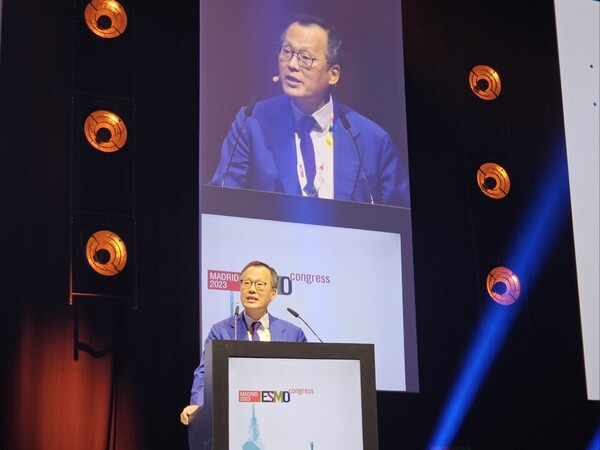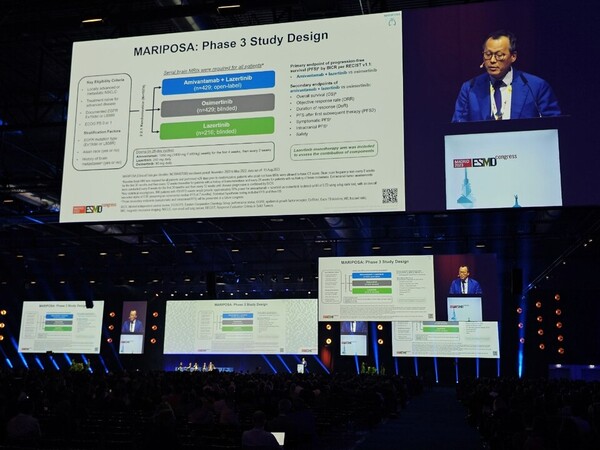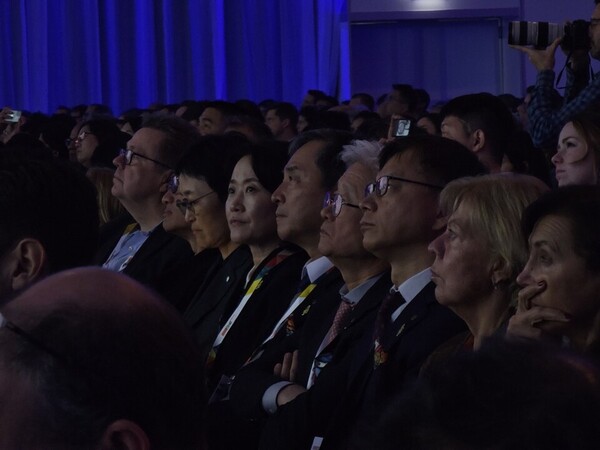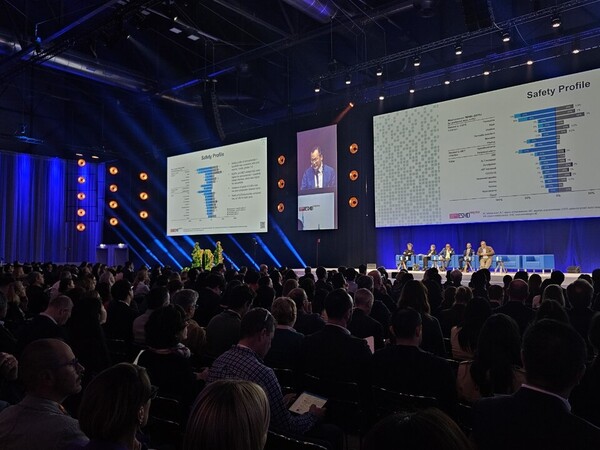MADRID -- By Kim Chan-hyuk Korea Biomedical Review correspondent -- The combination of Yuhan's Leclaza (lazertinib) and Janssen's Rybrevant (amivantamab) has been unveiled at the just-ended European Society for Medical Oncology (ESMO) 2023, Europe's largest cancer congress.
On Monday, the results from the MARIPOSA1 study were presented at the Ipema Convention Center in Madrid, Spain, during the congress' highlight, the Presidential Session. Dr. Cho Byoung-chul, director of the Lung Cancer Center at Yonsei Cancer Center, Yonsei University Severance Hospital, presented the study.
Janssen, which has global rights to Leclaza, conducted the global phase 3 trial (MARIPOSA1) to determine the efficacy of the combination of its EGFR-MET bispecific antibody Rybrevant and Leclaza as the first-line treatment of metastatic EGFR-positive non-small cell lung cancer (NSCLC).
MARIPOSA1 randomized 1,074 patients with previously untreated EGFR mutation (Ex19del or L858R)-positive NSCLC in a 2:2:1 ratio to Rybrevant plus Leclaza, Tagrisso alone and Leclaza alone to assess safety and efficacy.
The primary endpoint was progression-free survival (PFS) as assessed by the blinded independent central review (BICR), and secondary endpoints included overall survival (OS), objective response rate (ORR), duration of response (DoR), secondary progression-free survival (PFS2), and safety.

According to Professor Cho's presentation, at a median follow-up of 22.0 months, mPFS was 23.7 months (95 percent CI 19.1-27.7) for the Rybrevant+Leclaza combination and 16.6 months (95 percent CI 14.8-18.5) for Tagrisso alone, with Rybrevant+Leclaza reducing the risk of disease progression or death by 30 percent compared to Tagrisso alone (HR=0.70, 95 percent CI 0.58-0.85, P<0.001).
The ORR was 86 percent for the Rybrevant+Leclaza combination and 85 percent for Tagrisso alone, with a median DoR of 25.8 months and 16.8 months, respectively. In addition, PFS2 showed a 25 percent reduction in the risk of disease progression or death with the Rybrevant plus Leclaza combination compared to Tagrisso alone (HR=0.75, 95 percent CI 0.58-0.98).
For OS, data are not yet fully complete due to ongoing follow-up, but the study confirmed that the combination of Rybrevant and Leclaza reduced the risk of death by 20 percent (HR=0.80, 95 percent CI 0.61-1.05, P=0.11).
The presentation also included safety data not disclosed in the abstract. Grade 3 or higher adverse events (AEs) occurred in 8 percent of patients in the Rybrevant+Leclaza combination and 7 percent in Tagrisso alone. Serious adverse events occurred in 49 percent of Rybrevant plus Leclaza combination patients and 33 percent in Tagrisso alone.
The median treatment duration was 18.5 months for Rybrevant plus Leclaza and 18 months for Tagrisso alone. Treatment discontinuation rates due to treatment-related adverse events were 10 percent for Rybrevant plus Leclaza and 3 percent for Tagrisso alone.
Dr. Cho concluded that the combination of Rybrevant and Leclaza provided a clinically meaningful and statistically superior improvement in PFS, with a higher DoR and a favorable OS trend. He expected the combination of Rybrevant plus Leclaza to d become the new standard of care (SOC) in treating EGFR mutation-positive NSCLC.
Meeting with reporters after the presentation, Professor Cho also emphasized that in addition to the primary endpoint of PFS, the secondary endpoints of PFS2 and OS in this study are noteworthy.
In particular, as the abstract of Mariposa1 was released before the opening of ESMO, he pointed out the limitations of a direct comparison with the results of Tagrisso plus chemotherapy (FLAURA2). The FLAURA2 mPFS, presented at the International Association for the Study of Lung Cancer (IASLC) 2023 WCLC in September, was 25.5 months.
"MARIPOSA1 required brain MRIs every eight weeks, whereas FLAURA2 was clinically indicated in patients with confirmed brain metastases," Cho said. “Abdominal and chest CT scans were also more frequent in MARIPOSA1. Frequent imaging inevitably leads to more lesions being detected, which numerically translates into a shorter PFS."
Cho also noted that the Rybrevant plus Leclaza combination left chemotherapy as the only option after third-line EGFR-TKI treatment. The combination improved PFS2 without affecting subsequent treatment, which is critical to improving OS, the most important outcome for patients.
"At the end of the day, what matters most to patients is OS," Cho said. "Although the OS data did not meet statistical significance at the time of publication, we expect to see a widening gap in overall survival between the Rybrevant and Leclaza combination and Tagrisso monotherapy in the future."




Related articles
- [ESMO 2023] Keytruda-Padcev combo takes 'crown’ as 1st-line cure for urothelial cancer
- [ESMO 2023] Lunit, Medpacto, TiumBio present research results at ESMO 2023
- [ESMO 2023] Keytruda cements its position as 1st-line treatment for HER2+ gastric cancer
- [ESMO 2023] ‘HLB will apply for European authorization for rivoceranib this year’
- [ESMO 2023] Global competition for anticancer therapies opens yearly event in Europe
- [CPHI 2023] Prestige Biopharma embraces open innovation for new antibody drugs
- [ESMO 2023] GI Innovation lays ground for Keytruda’s clinical trials
- Yuhan's Leclaza aims to enter US market based on MARIPOSA study’s success
- ‘Leclaza shows efficacy on patients with lung cancer metastasized to brain’
- Yuhan secures full approval for Leclaza as 1st-/2nd-line treatment for NSCLC

